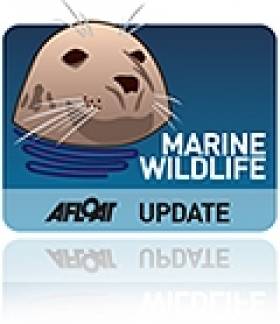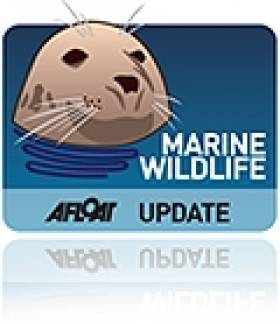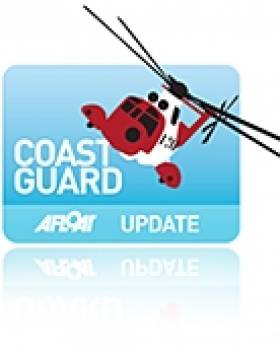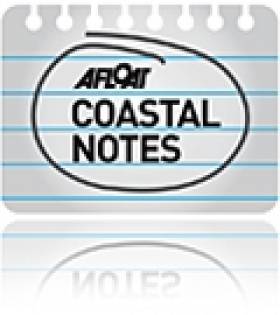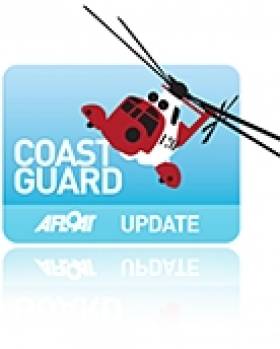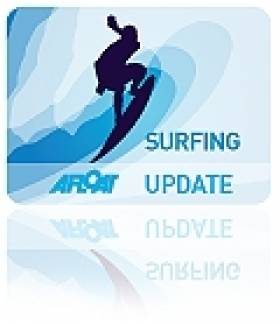Displaying items by tag: Doolin
Doolin's Dolphin Dusty 'More Jumpy' Than She Used To Be
#Dusty - Renewed warnings have been made to the public to keep a wide berth from Doolin's dolphin Dusty as the Irish Examiner reports she's "more jumpy" than usual.
Last summer the female bottlenose earned a degree of infamy after attacking a number of bathers in the Co Clare town, one of whom suffered eight spinal fractures, two broken ribs and lung damage in their altercation.
As we get closer to this year's summer, it may be tempting to join Dusty in the water for typical dolphin frolics, but Vanessa Fagan-Vanhorn of Dolphin Day Ireland strongly advises against it.
“[Disty] is definitely more jumpy and easier to startle than she used to be," she says. "The incidents of last summer do seem to have had an effect and her behaviour has changed."
The Irish Examiner has more on the story HERE.
Doolin Dolphin Victim Calls For Total Swimming Ban
#DolphinAttack - A woman who suffered serious injuries after being struck by the snout of Doolin's dolphin resident Dusty has criticised the lack of warning signs in the harbour at the time.
As RTÉ News reports via the Irish Independent, Valerie Ryan is calling for a total swimming ban in the area after suffering eight spinal fractures, two broken ribs and lung damage in the incident on 28 July last.
The self-employed osteopath has been forced out of work for six months due to her injuries.
Hers was the fourth such altercation with Dusty, a 14-year-old female bottlenose dolphin, recorded at that point this summer.
It has since emerged that the dolphin may have been acting aggressively in reaction to mistreatment by certain members of the public on various occasions.
Warning signs have since been erected in the area by Clare County Council, in line with advice from the Irish Whale and Dolphin Group that no one should swim with any of the whales or dolphins that frequent Ireland's waters - activity that puts both humans and cetaceans at risk.
"This dolphin is a wild animal and people should take serious account of that," said Liam Griffin, water safety officer with Clare County Council.
Doolin Dolphin Antagonised By Loutish Visitors
#MarineWildlife - The Irish Whale and Dolphin Group (IWDG) has urged people in Doolin to refrain from swimming with or even approaching Dusty the dolphin after it emerged the cetacean has been tormented by loutish visitors.
As reported on Afloat.ie last week, a woman was hospitalised after being struck by the dolphin's nose in what was just one of a spate of incidents involving the 14-year-old female bottlenose at the Co Clare town.
However the Irish Examiner reports that the marine mammal may only be reacting to antagonising behaviour such as fin grabbing by some swimmers and visitors in the Doolin area - with one group of campers allegedly trying to pour cider down her blowhole.
Speaking after the latest attack late last month, Dr Simon Berrow of the IWDG commented: "It is IWDG policy to discourage people swimming with whales and dolphins in Ireland. The risk is not only to humans but also to the dolphin as habituation to humans increases risk of injury or death to the dolphin.
"Around 80% of such interactions worldwide end up in the death or severe injury of the dolphins involved."
Dusty The Dolphin Gets Dangerous With Doolin Dippers
#MarineWildlife - Dusty the dolphin has injured yet another swimmer off Doolin Pier in Co Clare in the latest of a recent spate of incidents, as The Irish Times reports.
Last night a woman was hospitalised after being struck by the dolphin's nose in the kidney area, leaving her "badly bruised and shocked by the incident".
It's since emerged that this was the fourth such attack by the bottlenose dolphin in the past month.
The cetacean responsible - a 14-year-old female - has made Doolin her home after many years in the Fanore area, and has apparently been responsible for a number of attacks on swimmers over the last two years.
But visitors continue to swim with the dolphin despite warnings by the Irish Whale and Dolphin Group (IWDG), which discourages any interference with the protected species.
The Irish Times has more on the story HERE.
Minister Approves New Coastguard Station for Doolin
#Coastguard - Minister for Transport Leo Varadkar has given approval for the construction of a new volunteer coastguard station in Doolin, Co Clare.
The €1.8-million project, to be overseen by the Office of Public Works, will be tendered within a matter of weeks, with construction expected to start in early April.
The Doolin unit of the Irish Coast Guard is one of the busiest in the country and operates a cliff rescue team, a boat unit and shoreline search team. The 24-member team is supported by seven additional volunteers located on nearby Inisheer.
The unit was featured on the recent RTÉ programme Ireland’s Search & Rescue conducting cliff and boat rescue operations.
Volunteers currently operate out of a temporary premises and a nearby rented farm shed. The new station will provide a garage area for the storage of boats, cliff rescue, personal equipment and transport as well as changing facilities and an operations room.
Minister Varadkar said: "I am delighted to be able to confirm funding for the new Doolin coastguard station. I am very conscious of the demands placed on the unit and I am keen to provide them with a base to so they can continue to serve their community and the many visitors to the Doolin area, including the Cliffs of Moher.
“In both 2012 and 2011 the Doolin unit responded to over 40 call-outs each year. This is a long-term investment in the Doolin area and acknowledges the efforts and service that the volunteers continue to provide.”
The Doolin coastguard unit is currently awaiting an update on long-delayed plans to redevelop the pier facilities at Doolin, which rescuers argue are "regularly over-congested" in peak tourist periods - though the current plans face opposition from local surfers who fear a negative impact on the renowned Crab Island surf break in the area.
Surfers, Islanders Clash at Doolin Pier Hearing
#COASTAL NOTES - Clare surfers say they have no confidence that development plans for Doolin Pier will not have a negative impact on the Crab Island surf break.
The Irish Examiner reports on an oral hearing on the project held by An Bord Pleanála in Ennistymon on Wednesday morning at which representatives of the Irish Surfing Association and the West Cost Surf Club expressed their fears of losing "the jewel in the crown" of Irish surfing.
As previously reported on Afloat.ie, local surfers have been at loggerheads with Clare County Council over long-delayed plans to redevelop the pier facilities at Doolin, which currently serves more than 70,000 passengers between the Clare coast and the Aran Islands.
At present the pier cannot be accessed at low tide, and foul weather cost the ferry route to 40 days's business last year, the meeting heard.
Island co-op Comhar Caomhán Inis Oírr is among the groups supporting the €8 million development plans, arguing that the islands would be "under threat" if the project does not proceed.
Surfers To Clash With Council Over Doolin Development
#DOOLIN PIER - The Irish Times reports that surfers will be at loggerheads with Clare County Council this week over controversial plans to redevelop Doolin Pier.
The €8 million plans for the Clare coastal village have been delayed for some time, and have already cost the council more than €250,000.
As previously reported on Afloat.ie, the development was backed unanimously by Clare councillors in March 2011 after revisions made following concerns from local surfers about its impact on popular waves in the area.
However, the Irish Surfing Association (ISA) maintained that even that revised plan would result in the elimination of the waves at Doolin Point and Crab Island - the latter described as Ireland's answer to the Pipeline in Hawaii.
The proposed new pier would serve the 70,000 passengers that use the ferry service between Doolin and the Aran Islands. The development is also supported by the Doolin unit of the Irish Coast Guard, which hopes to get a new coastguard station as part of development plans for the area.
Divers Meet Dusty the Doolin Dolphin
#MARINE WILDLIFE - A hat-tip goes to WorldIrish for this video posted on Vimeo by Monty Cantson capturing the moment when a playful dolphin paid a visit to a group of divers in Bones Bay at Doolin, Co Clare recently.
According to Lahinch Surf Experience, the bottlenose dolphin goes by the name of Dusty, after the singer Dusty Springfield.
The female cetacean has been a fixture of the area for more than a decade, and while apparently less friendly than Dingle's famous Fungie - she doesn't like to be touched - she seems happy to swim beside swimmers and divers, and loves to play with anything you might have in the water with you!
Eight Searches at Cliffs of Moher in 2011 for Doolin Coastguard
#COASTGUARD - The Irish Coast Guard's Doolin unit conducted eight searches for missing people at the Cliffs of Moher in 2011, according to The Irish Times.
Doolin officer Mattie Shannon told the paper that six bodies were recovered by the coastguard unit of the cliffs, which are one of the most popular tourist destinations in the country - but have also become a blackspot for suicide attempts.
The Samaritans have put up signs in the area advertising their helpline, while staff at the cliffs' visitor centre have received training for suicide intervention.
A spokesperson for The Samaritans said that the installation of a special phone with a direct line to their anonymous counselling service may also be considered.
The Irish Times has more on the story HERE.
Surfers Welcome New Ruling on Doolin Pier Development
Surfers have hailed the recent ruling by An Bord Pleanála that Clare County Council must reapply for planning permission for its proposed €6 million redevelopment of Doolin Pier.
As previously reported on Afloat.ie, local surfers and the Irish Surfing Association (ISA) had expressed dismay over the current development plans – approved by the council earlier this year – which they maintain would result in the destruction of the "world renowned" waves at Doolin Point and Crab Island.
The Irish Times reports that the council must now resubmit its planning application and prepare and environmental impact statement (EIS) due to the potential impact on tidal and wave patterns in the area, setting back plans for at least a year.
The proposed scheme already has support from the local business community and the Doolin Coast Guard unit, which argues that congestion on the pier in peak tourist periods may interfere with rescue efforts.
A spokesperson for the West Coast Surf Club said that both it and the ISA were available "to meet with the council to progress a mutually agreeable design for the pier".
The Irish Times has more on the story HERE.


























